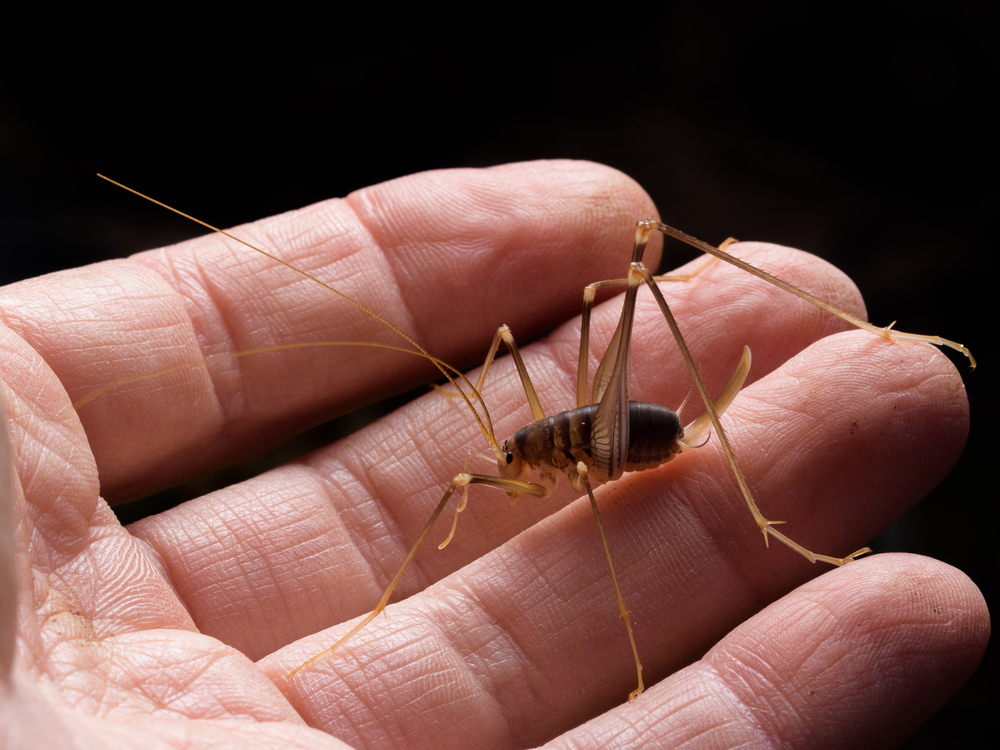


While they aren't poisonous or dangerous in any way, spider crickets are nuisance household pests that your home's better off without. These dreadful pests thrive in moist environments such as damp basement and crawl spaces, also known as cave crickets, cave weta, camel cricket, and camelback cricket. They’re voracious eaters that will virtually forage just about anything, be it wood, cardboard, carpet, and even each other.
How exactly do you get rid of these unwanted creatures? They’re creepy to encounter because they're fairly large bugs that are ferocious-looking and seem to be all legs and antennae, but if you're up for the challenge, here are the different ways to repel spider crickets.
You can purchase a sticky trap or glue trap from the hardware or home improvement store, but you can also simply make one using duct tape. Adding bait to your DIY cricket traps will increase your chance of catching them. You can place just about any food as bait, but some of the most commonly used cat food and moldy bread.
Soapy water is one of the most straightforward and inexpensive solutions for a spider cricket infestation. Fill up bowls with soapy water and leave them in your basement where crickets typically lurk. Spider crickets are drawn to water and will hurriedly jump into these bowls only to drown. The purpose of soap is to counteract the waxy coating of the spider cricket's exoskeleton, so they drown more quickly.
If you want a quick and easy way to eradicate spider crickets, an effective instrument is an electronic rat trap, which kills these pests instantly. When purchasing an electronic rat trap, make sure that it works with moisture instead of infrared heat.
Rat traps activated by infrared won't work because spider crickets are poikilotherms, and their surroundings strongly affect their internal body temperature since they can’t maintain thermal homeostasis. It's interesting to note that electronic rat traps have enough current to fry a cricket so quickly that it bursts with a distinct crackling sound.
Another effective method in killing spider crickets and other pesky flying insects is by using bug-zapping rackets. However, you have to make sure to avoid touching the wires since it zaps anything that comes close to the wire with hundreds or even thousands of volts. It's not fatal as it's battery-powered, but the electric shocks can result in second-degree burns.
Bug vacuum devices are reliable in catching spider crickets that are difficult to reach. They’re also easy to use, and you won't need to clean up the mess instead of squishing pests. Stamping on insects seems to be the easy way out, but you'll still have to clean the area and dispose of the dead insects after, which is a hassle and inconvenience. But with bug vacuum devices, this won’t be an issue. You can use the long head of these vacuums to get to otherwise inaccessible areas quickly.
You can catch annoying bugs instantly and securely with these vacuum devices. Aside from spider crickets, bug vacuums are also effective in trapping other insects like flies, spiders, mosquitoes, cockroaches, wasps, and whatnot. One reason bug vacuums are safe is that they don't have toxic chemicals.
Cats can help control camel cricket infestation in your home. For these feline animals, hunting and eating bugs are both intuitive and thrilling since bugs are tiny and rush, specifically the creatures that cats' brains defaulted to chase. This isn’t just confined to feral cats. Even domestic cats have a natural predatory way. This instinct is always seen when they bring back the prey they have hunted back into the house where they live.
Though, bear in mind that they won't be of much use if you already have a massive population of spider crickets infesting your house. As agile and predatory as it is, one cat also has its limits, while spider cricket populations can grow up to hundreds.
Preventing the spider cricket population from getting out of hand means ensuring that the moisture levels in your home remain low. You can use a dehumidifier to control dampness levels, which in turn will lessen the influx of spider crickets into your place.
Your house may be wet if the indoor surroundings feel clammy if a musty odor continues in a humid climate. Your space may also be wet if visible condensation on walls or ceilings is noticeable. If dampness continues despite fixing water leaks, then you should buy a dehumidifier.
To choose the right-sized dehumidifier apt for your needs, you must first determine the dimensions of your room with a tape measure. Determine the width and length of the room and multiply these two dimensions together to discover the area covered. This will help you specify the size of the dehumidifier that you need. The capability of dehumidifiers is provided in pints. This is the amount of water that a dehumidifier can remove from the living space in one day. A 30-pint dehumidifier is enough for a damp area between 500 and 1,500 feet, while a 50-pint dehumidifier will be enough for damp places between 2,000 and 2,500 square feet in size.
Don’t allow dense vegetation to grow near your home’s walls since it can draw spider crickets. Trim your lawn routinely, and don't let tall grass grow further. Double-check if the surrounding of your home is free from trash accumulation because spider crickets and other insect pests feast on the waste and rotting food. Keep trash bins away from your premises and empty all your bins routinely.
Spider crickets get inside your home through crevices and cracks on walls and window sills. First, seal these cracks to block an entry point to these insects. Next, close your doors and windows.
If you need to keep your window open, ensure that window mosquito nets are properly installed to stop spider crickets and other insects from trespassing on your property. Remember to seal your house and keep your living space dehumidified. If you don’t, the spider crickets will keep coming back.
Begin spider cricket control outside of your home. Use insecticide to spray this space. This low odor concentrate is dissolvable in water. Spray under decks, sheds, doorways, windows, and foundation walls.
Spray on electric wires, Air-conditioning units, and whatnot. Add 0.8 oz of this liquid to a gallon of liquid. One to two gallons of this solution is sufficient for most homes. Spray this liquid around once a month to halt cave cricket infestation.
If you prefer a non-toxic solution to your cricket problem, diatomaceous earth is highly recommended. Also referred to as DE, fine, talc-like, and off-white powder consists of finely crumbled remains of fossilized marine phytoplankton. It can lacerate the spider cricket's exoskeletons, which leads them to death by dehydration. DE is safe for children and pets and is available at garden supply centers.
Another all-natural spider cricket repellent is cedar oil. You can concoct your bug spray by mixing cedar oil with water in a spray bottle. When the crickets touch the oil, they go through osmotic dehydration and die.
Alternatively, you can also use neem oil. The compounds found in this oil can destabilize the hormonal system of these insects. As a result, they affect the insects' ability to eat, mate, and lay eggs.
Boric acid is a widely used bait ingredient for insect control. When pests usually found at home such as spider crickets unwittingly consume boric acid, they dehydrate from the inside. They’ll then die in two or three days.
Crickets, be it spider cricket, house cricket, field cricket, and mole crickets, don't live in colonies and don't eat communally, so you want a high concentration to make them die as quickly as possible.
Learn More: Plants That Repel Spiders
Generally mistaken for a wolf spider, the spider cricket is aptly named because it has six long legs that look very alike to a huge arachnid. Although called a spider cricket, this pest isn’t a true cricket.
They’re insects that belong to the Rhaphidophoridae family. This is an invasive species from China. It was carried to North America via human travel and is now a prevalent pest throughout the United States.
Spider crickets love it when there’s moisture, and they’re most common in humid environments. This is why it's not surprising that they’re seen in the Southern US. While they typically live outdoors in wood piles or greenhouses, gardens, and lush landscapes, these cricket species are also known to invade and reproduce in homes if conditions are appropriately damp.
Once inside, these occasional invaders, similar to stink bugs, tend to congregate in dark basements, attics, and crawl space, where moisture builds up. Food and water are abundantly available to them. They feast on fungus, fabric, cardboard, dust, plants, and even each other. Their mandibles are powerful, and they can chew through many different household items.
Another fascinating fact about these species is that they don't make the usual chirping sounds that a regular cricket makes. Instead, they draw mates by releasing a smell from their bodies, which means reproduction can increase when they're trapped collectively in a small space with little ventilation. They’re silent, nocturnal insect species, but their defense mechanism is to jump very high when startled or threatened when they venture beyond their hiding place.
Does the spider cricket bite humans? The straightforward answer is that they don't because the bug's mandibles are for chewing their animal prey and not inflicting a bite in self-defense. These creatures would jump in self-defense, but if they land on your skin, they can begin gnawing, which could be painful to you.
Learn More: What To Put On A Spider Bite

Spider crickets are problematic pests that like to feed on curtains, carpets, and clothes in your closet. On top of this, they congregate in large numbers, rapidly reproduce, and emit a foul smell inside homes during large infestations.
If these pests have become an alarming concern to you and your loved ones, getting professional help is an intelligent decision. A licensed pest control expert can develop a treatment plan for attacking the problem inside and outside your dwelling.
If you're looking for the right partner, trust only PermaKill Exterminating. We treat your home like ours, which means your problems are our problems. You're not just a customer; you're a homeowner whose problem needs to be addressed as soon as possible.
From troublesome spider crickets to intrusive ants and angry bees, we'll help you manage house pests from start to finish. Contact PermaKill Exterminating today and schedule your free estimate.